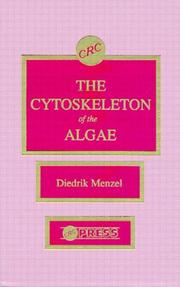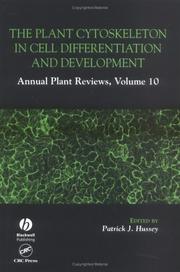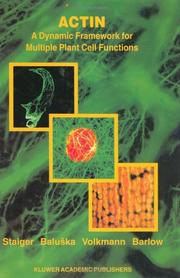| Listing 1 - 9 of 9 |
Sort by
|

ISBN: 0849366798 Year: 1992 Publisher: London CRC Press
Abstract | Keywords | Export | Availability | Bookmark
 Loading...
Loading...Choose an application
- Reference Manager
- EndNote
- RefWorks (Direct export to RefWorks)
Dicotyledons --- Cytosquelette végétal --- Plant cytoskeleton --- Plantecytoskelet --- Algae --- Cytology --- Algae - Cytology. --- Plant cytoskeleton.

ISBN: 0849319811 1841274216 Year: 2004 Publisher: Oxford : Blackwell,
Abstract | Keywords | Export | Availability | Bookmark
 Loading...
Loading...Choose an application
- Reference Manager
- EndNote
- RefWorks (Direct export to RefWorks)
Cell Differentiation. --- Cytoskeleton --- Plant and Crop Sciences. Botany --- Plant cell development. --- Plant cell differentiation. --- Plant cytoskeleton. --- Plants --- physiology. --- Plant Cell Biology. --- cytology.
Book
ISBN: 0124537707 9780124537705 Year: 1991 Publisher: London Academic Press
Abstract | Keywords | Export | Availability | Bookmark
 Loading...
Loading...Choose an application
- Reference Manager
- EndNote
- RefWorks (Direct export to RefWorks)
Phytohistology. Phytocytology --- Phytomorphology. Phytoanatomy --- Plant embryology and development --- Croissance (Plantes) --- Cytosquelette végétal --- Groei (Planten) --- Growth (Plants) --- Plant cytoskeleton --- Plant growth --- Plantecytoskelet --- Planten--Groei --- Plantengroei --- Plants--Growth --- Botany --- Morphology --- Plant cytoskeleton. --- Plant morphogenesis. --- Botany and plant sciences --- Cellular development --- Plants --- Cells --- Plant Cell Biology --- Cellular Biology --- PLANTS --- CYTOSKELETON --- PLANT GROWTH --- PLANT DEVELOPMENT --- PLANT CELLS --- PLANT CELL WALLS --- TEXTBOOKS --- MORPHOLOGY
Book
ISBN: 0124537804 Year: 1982 Publisher: London
Abstract | Keywords | Export | Availability | Bookmark
 Loading...
Loading...Choose an application
- Reference Manager
- EndNote
- RefWorks (Direct export to RefWorks)
Plant embryology and development --- 576.31 --- 581.14 --- Plant cytoskeleton --- Plant morphogenesis --- #WPLT:dd.prof.J.Vendrig --- Plant embryology --- Plant morphology --- Morphogenesis --- Cytoskeleton --- Plant cells and tissues --- Cell morphology --- Development --- Plant cytoskeleton. --- Plant morphogenesis. --- Basic Sciences. Genetics --- Cytogenetics --- Cytogenetics. --- 581.14 Development --- 576.31 Cell morphology
Book
ISBN: 9781402088438 1402088426 9781402088421 9786611853747 1281853747 1402088434 1402088418 Year: 2008 Publisher: Dordrecht : Springer-Science+Business Media, B.V.,
Abstract | Keywords | Export | Availability | Bookmark
 Loading...
Loading...Choose an application
- Reference Manager
- EndNote
- RefWorks (Direct export to RefWorks)
Essential processes in biology such as cell and nuclear division, development, intracellular transport and physiological response, rely on the perception of environmental and intracellular signals and their transduction to subcellular targets. The mechanisms by which these signals are received by cells and transduced towards the proper targets by cytoskeletal components constitute one of the most important and rapidly developing areas in modern plant biology. In addition, fundamentally important responses of plants to biotic and abiotic factors also involve signalling to and through the cytoskeleton, which helps explain the current interest of biotechnology in this field of fundamental research. Manipulation of cytoskeletal components, the microtubules and microfilaments, had, until recently, not been a priority issue for plant biotechnology. However, given the fundamental role of the cytoskeleton during plant growth and development, the potential for biotechnological applications is immense. The NATO Advanced Research Workshop, “The Plant Cytoskeleton: Genomic and Bioinformatic Tools for Biotechnology and Agriculture” was held in Yalta, Ukraine, from September 19 to 23, 2006 – which continued the tradition of the first two International Symposia “Plant Cytoskeleton: Molecular Keys for Biotechnology” (Yalta, Ukraine, 1998) and “The Plant Cytoskeleton: functional diversity and biotechnological implications” (Kiev, Ukraine, 2002).
Life Sciences. --- Cell Biology. --- Biotechnology. --- Pharmacology/Toxicology. --- Plant Genetics & Genomics. --- Life sciences. --- Toxicology. --- Cytology. --- Plant breeding. --- Sciences de la vie --- Toxicologie --- Biotechnologie --- Cytologie --- Plantes --- Amélioration --- Plant cytoskeleton -- Congresses. --- Plant cytoskeleton. --- Plants. --- Plant Physiology --- Cytology --- Botany --- Biology --- Health & Biological Sciences --- Earth & Environmental Sciences --- Plant cytoskeleton --- Pharmacology. --- Cell biology. --- Plant genetics. --- Cytoskeleton --- Plant cells and tissues --- Plant Genetics and Genomics. --- Chemical engineering --- Genetic engineering --- Plants --- Genetics --- Chemicals --- Medicine --- Pharmacology --- Poisoning --- Poisons --- Cell biology --- Cellular biology --- Cells --- Cytologists --- Toxicology --- Drug effects --- Medical pharmacology --- Medical sciences --- Chemotherapy --- Drugs --- Pharmacy --- Physiological effect --- Crops --- Agriculture --- Breeding
Book
ISBN: 9781441909879 9781441909862 Year: 2011 Publisher: New York, NY Springer New York
Abstract | Keywords | Export | Availability | Bookmark
 Loading...
Loading...Choose an application
- Reference Manager
- EndNote
- RefWorks (Direct export to RefWorks)
Plant cells house highly dynamic cytoskeletal networks of microtubules and actin microfilaments. They constantly undergo remodeling to fulfill their roles in supporting cell division, enlargement, and differentiation. Following early studies on structural aspects of the networks, recent breakthroughs have connected them with more and more intracellular events essential for plant growth and development. Advanced technologies in cell biology (live-cell imaging in particular), molecular genetics, genomics, and proteomics have revolutionized this field of study. Stories summarized in this book may inspire enthusiastic scientists to pursue new directions toward understanding functions of the plant cytoskeleton. The Plant Cytoskeleton is divided into three sections: 1) Molecular Basis of the Plant Cytoskeleton; 2) Cytoskeletal Reorganization in Plant Cell Division; and 3) The Cytoskeleton in Plant Growth and Development. This book is aimed at serving as a resource for anyone who wishes to learn about the plant cytoskeleton beyond ordinary textbooks. Bo Liu is professor in the Department of Plant Biology at the University of California in Davis, California. He received his B.S. degree in cell biology and genetics and M.S. degree in cell biology from Peking University in Beijing, China, and Ph.D. degree in botany from the University of Georgia in Athens, Georgia. Research in his laboratory is focused on studying the cytoskeletal basis of intracellular motility in flowering plants and filamentous fungi.
Plant physiology. Plant biophysics --- Botany --- systematische plantkunde --- planten --- Plant cytoskeleton --- Plant cell development --- Plant cell differentiation --- Plantes --- Cytosquelette --- Cellules et tissus --- Développement --- Différenciation --- EPUB-LIV-FT LIVBIOLO LIVBIOMO LIVMEDEC SPRINGER-B
Book
ISBN: 1441909869 1441909877 Year: 2010 Publisher: New York, NY : Springer Science+Business Media, LLC,
Abstract | Keywords | Export | Availability | Bookmark
 Loading...
Loading...Choose an application
- Reference Manager
- EndNote
- RefWorks (Direct export to RefWorks)
Plant cells house highly dynamic cytoskeletal networks of microtubules and actin microfilaments. They constantly undergo remodeling to fulfill their roles in supporting cell division, enlargement, and differentiation. Following early studies on structural aspects of the networks, recent breakthroughs have connected them with more and more intracellular events essential for plant growth and development. Advanced technologies in cell biology (live-cell imaging in particular), molecular genetics, genomics, and proteomics have revolutionized this field of study. Stories summarized in this book may inspire enthusiastic scientists to pursue new directions toward understanding functions of the plant cytoskeleton. The Plant Cytoskeleton is divided into three sections: 1) Molecular Basis of the Plant Cytoskeleton; 2) Cytoskeletal Reorganization in Plant Cell Division; and 3) The Cytoskeleton in Plant Growth and Development. This book is aimed at serving as a resource for anyone who wishes to learn about the plant cytoskeleton beyond ordinary textbooks. Bo Liu is professor in the Department of Plant Biology at the University of California in Davis, California. He received his B.S. degree in cell biology and genetics and M.S. degree in cell biology from Peking University in Beijing, China, and Ph.D. degree in botany from the University of Georgia in Athens, Georgia. Research in his laboratory is focused on studying the cytoskeletal basis of intracellular motility in flowering plants and filamentous fungi.
Plant cytoskeleton. --- Plant physiology. --- Botany --- Plants --- Physiology --- Life sciences. --- Plant science. --- Botany. --- Plant anatomy. --- Plant development. --- Plant genetics. --- Life Sciences. --- Plant Sciences. --- Plant Anatomy/Development. --- Plant Genetics & Genomics. --- Cytoskeleton --- Plant cells and tissues --- Plant Genetics and Genomics. --- Genetics --- Plant structure --- Structural botany --- Vegetable anatomy --- Anatomy --- Botanical science --- Phytobiology --- Phytography --- Phytology --- Plant biology --- Plant science --- Biology --- Natural history --- Structure --- Development of plants --- Plant development --- Developmental biology --- Growth (Plants) --- Ontogeny --- Floristic botany

ISBN: 0792364120 9048155045 9401594600 Year: 2000 Publisher: Dordrecht Kluwer
Abstract | Keywords | Export | Availability | Bookmark
 Loading...
Loading...Choose an application
- Reference Manager
- EndNote
- RefWorks (Direct export to RefWorks)
Actin is an extremely abundant protein that comprises a dynamic polymeric network present in all eukaryotic cells, known as the actin cytoskeleton. The structure and function of the actin cytoskeleton, which is modulated by a plethora of actin-binding proteins, performs a diverse range of cellular roles. Well-documented functions for actin include: providing the molecular tracks for cytoplasmic streaming and organelle movements; formation of tethers that guide the cell plate to the division site during cytokinesis; creation of honeycomb-like arrays that enmesh and immobilize plastids in unique subcellular patterns; supporting the vesicle traffic and cytoplasmic organization essential for the directional secretory mechanism that underpins tip growth of certain cells; and coordinating the elaborate cytoplasmic responses to extra- and intracellular signals. The previous two decades have witnessed an immense accumulation of data relating to the cellular, biochemical, and molecular aspects of all these fundamental cellular processes. This prompted the editors to put together a diverse collection of topics, contributed by established international experts, related to the plant actin cytoskeleton. Because the actin cytoskeleton impinges on a multitude of processes critical for plant growth and development, as well as for responses to the environment, the book will be invaluable to any researcher, from the advanced undergraduate to the senior investigator, who is interested in these areas of plant cell biology.
Phytohistology. Phytocytology --- Phytochemistry. Phytobiochemistry --- Actin. --- Myosin. --- Plant cellular control mechanisms. --- Plant cytoskeleton. --- Plant and Crop Sciences. Botany --- Plant Cell Biology --- Plant Cell Biology. --- Plant science. --- Botany. --- Proteins . --- Biochemistry. --- Plant physiology. --- Plant pathology. --- Microscopy. --- Plant Sciences. --- Protein Science. --- Biochemistry, general. --- Plant Physiology. --- Plant Pathology. --- Biological Microscopy. --- Analysis, Microscopic --- Light microscopy --- Micrographic analysis --- Microscope and microscopy --- Microscopic analysis --- Optical microscopy --- Optics --- Botany --- Communicable diseases in plants --- Crop diseases --- Crops --- Diseases of plants --- Microbial diseases in plants --- Pathological botany --- Pathology, Vegetable --- Phytopathology --- Plant pathology --- Plants --- Vegetable pathology --- Agricultural pests --- Crop losses --- Diseased plants --- Phytopathogenic microorganisms --- Plant pathologists --- Plant quarantine --- Physiology --- Biological chemistry --- Chemical composition of organisms --- Organisms --- Physiological chemistry --- Biology --- Chemistry --- Medical sciences --- Proteids --- Biomolecules --- Polypeptides --- Proteomics --- Botanical science --- Phytobiology --- Phytography --- Phytology --- Plant biology --- Plant science --- Natural history --- Pathology --- Diseases and pests --- Diseases --- Wounds and injuries --- Composition --- Floristic botany
Book
ISBN: 9783540771753 3540771751 3642095887 9786611273552 1281273554 3540771786 Year: 2008 Publisher: Berlin ; London : Springer,
Abstract | Keywords | Export | Availability | Bookmark
 Loading...
Loading...Choose an application
- Reference Manager
- EndNote
- RefWorks (Direct export to RefWorks)
Plant microtubules are key elements of cell growth, division and morphogenesis. In addition to their role in plant development and architecture, they have emerged as regulatory elements of signalling and important targets of evolution. Since the publication of the first edition of Plant Microtubules in 2000, our understanding of microtubules and their manifold functions have advanced substantially. Consisting of the following three parts, this book highlights the morphogenetic potential of plant microtubules from three general viewpoints: Microtubules and Morphogenesis: control of cell axis during division and expansion, cross-talk with actin filaments, mechanical properties of the cell wall. Microtubules and Environment: the role of microtubules during the sensing or response of environmental factors such as pathogens or abiotic stresses. Microtubules and Evolution: complexity and specialization of plant microtubules in the context of plant evolution. For those working in academia and applied science, the state of the art of a fascinating field of cell biology is given; for graduate and advanced students the most recent advances are positioned into a clear conceptual context. From the reviews of the first edition "The overall impression on this book is a very good sum of knowledge gathered around plant microtubules. ... The readability is very good and the overall scientific level at which the co-ordinated Authors have written their contribution is good to excellent." (Annals of Forest Sciences) "... a compact book, easy to handle with an excellent subject index. Illustrations and schematic models are highly instructive. ... It is highly recommendable." (Plant Science).
Plant microtubules. --- Plant micropropagation. --- Plant microtubules -- Molecular aspects. --- Growth and Development --- Cytoskeleton --- Phenomena and Processes --- Cytoplasmic Structures --- Physiological Processes --- Cytoplasm --- Physiological Phenomena --- Intracellular Space --- Cellular Structures --- Cells --- Anatomy --- Morphogenesis --- Plant Physiological Phenomena --- Microtubules --- Botany --- Earth & Environmental Sciences --- Plant Physiology --- Botany - General --- Microtubules. --- Cytotubules --- Life sciences. --- Biotechnology. --- Agriculture. --- Cell biology. --- Forestry. --- Plant science. --- Botany. --- Life Sciences. --- Plant Sciences. --- Cell Biology. --- Cell organelles --- Plant cytoskeleton --- Cytology. --- Forests and forestry. --- Chemical engineering --- Genetic engineering --- Forest land --- Forest lands --- Forest planting --- Forest production --- Forest sciences --- Forestation --- Forested lands --- Forestland --- Forestlands --- Forestry --- Forestry industry --- Forestry sciences --- Land, Forest --- Lands, Forest --- Silviculture --- Sylviculture --- Woodlands --- Woods (Forests) --- Agriculture --- Natural resources --- Afforestation --- Arboriculture --- Logging --- Timber --- Tree crops --- Trees --- Farming --- Husbandry --- Industrial arts --- Life sciences --- Food supply --- Land use, Rural --- Cell biology --- Cellular biology --- Biology --- Cytologists --- Botanical science --- Phytobiology --- Phytography --- Phytology --- Plant biology --- Plant science --- Natural history --- Plants --- Floristic botany
| Listing 1 - 9 of 9 |
Sort by
|

 Search
Search Feedback
Feedback About UniCat
About UniCat  Help
Help News
News